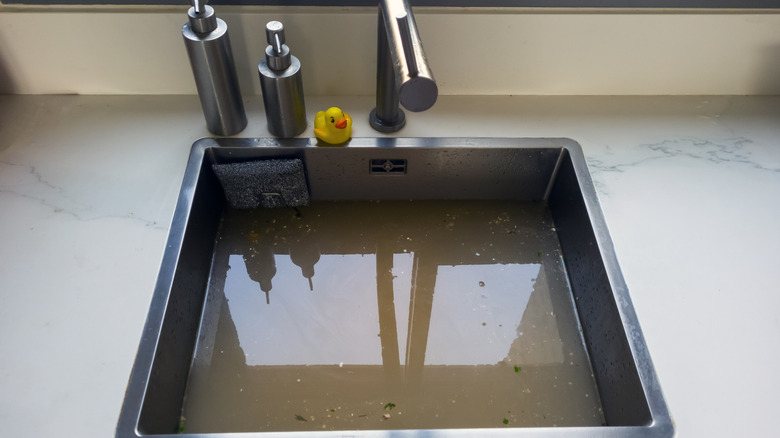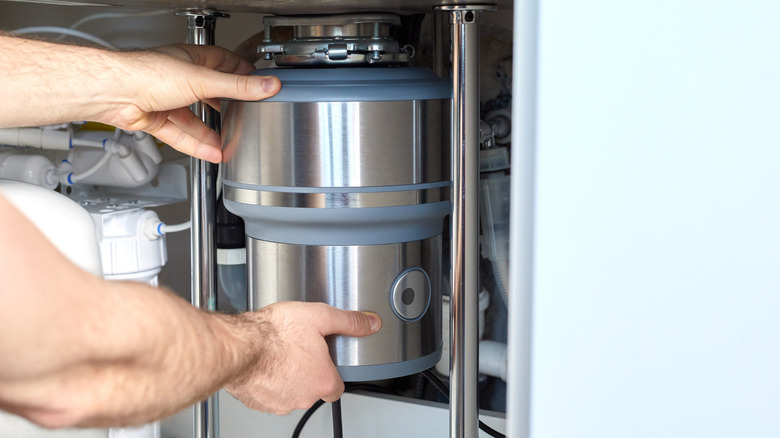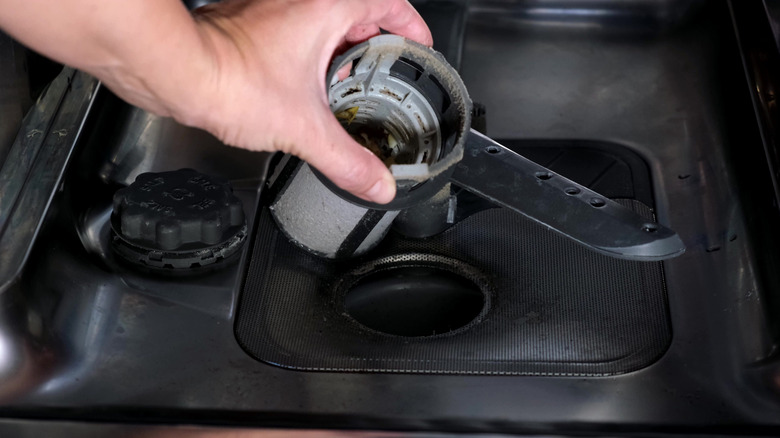If Your Dishwasher Is Backing Up Into The Sink, Here's What You Should Do
The dishwasher can easily be considered one of the greatest modern inventions, especially if you're someone who hates doing the dishes. Yet, as can happen with all appliances, sometimes your dishwasher malfunctions or doesn't perform as it should. And doesn't it always seem to happen when you have a sink full of dishes! A common dishwasher problem is when it backs into your sink, sending an array of food scraps and stinky water with it. Gross. Various reasons can cause a dishwasher to back up into the sink, and often, you might not be sure where to start. A garbage disposal backing up and a clogged air gap can be culprits, and if so, you need to address the problem by clearing the clogs or checking for any obstructions.
Dishwashers connect to your plumbing's hot water line and, if present, your garbage disposal. While going through the dish-washing cycle, the dishwasher will drain through the garbage disposal, not a separate drain. In most cases, this setup is fine and works smoothly. However, if there's a clog of food or grease somewhere in these connections, it can result in a backup in your sink from the dishwasher. Ignoring the issue isn't a solution because the clog may worsen and cause an overflow of water. Worst of all, it poses a sanitation risk if your clean dishes come into contact with the dirty water. Plus, it creates an ideal breeding environment for mold. To prevent this, here are a few ways to identify why your dishwasher backs up into the sink and how to stop it.
Your garbage disposal may be the culprit
Garbage disposals are meant to safely dispose of food waste by shredding it into small pieces that can easily pass through your home's plumbing system. Sometimes, though, your garbage disposal can develop a clog, such as when you put bones or other items you should never put in the garbage disposal there. If you think this is the case, first unplug your disposal to safely remove the blockage. Next, while wearing gloves, carefully remove any debris from the disposal with a pair of tongs. If that fails, you can try filling your sink with a bit of water and then use a special sink plunger to dislodge the clog. Avoid using a toilet plunger in your sink, as you need one with a flat cup. Once you've removed the clog, try to run the dishwasher again and see if that fixes the problem.
Your garbage disposal can also cause the dishwasher to back up into the sink if the disposal was newly installed with the knockout plug intact. The knockout plug is a piece of plastic in the disposal inlet where the line from your dishwasher attaches. When still in place, the knockout prevents the water from draining from the dishwasher to the garbage disposal. It's best to call a professional plumbing service if you suspect this is the case, as you likely need to uninstall the disposal completely to remove the plug.
Clogged air gaps or a dirty dishwasher filter may be to blame
Standing water in your dishwasher could also indicate a clog in your machine. First, remove all of the dishes so it's easier to work within the dishwasher and determine the problem. It may be your hard-working dishwasher filter that tirelessly captures all of the food scraps left on your plates during a wash cycle. If you need advice on how to remove and clean your dishwasher filter, check your owner's manual. Many dishwasher filters are in the appliance's bottom near the spray arm, often accessed by removing a plastic screw from a grate. Your dishwasher filter can get pretty gross, collecting all of those food scraps from your plates, so give it a thorough but gentle scrub with a toothbrush. You can also let it soak in a solution of warm water and distilled white vinegar to dislodge any tough residue.
A small cylinder piece next to your sink could be the reason for the backup as well. This piece, known as an air gap, helps create space between the clean, running water and the dirty water from the dishwasher to prevent backflow of the dirty water onto your clean dishes. Sometimes, there's a block in the air gap, which may result in your dishwasher backing into your sink. You may also see water leaking out the side of the air gap. Slide the cover off the air gap, then look for any debris in there or the hose, then remove it with tweezers. If none of these DIY methods work, then your best bet is to contact a professional plumbing service.


